↧
Monday Portraits
↧
Reminder: Hudson River Fellowship Salon Tomorrow!
Join us tomorrow, Friday, Oct. 4th from 5:30-7:30 p.m. for an informal exhibition of landscape drawings, paintings and studies from this summer's Hudson River Fellows, workshop participants and the Water Street Atelier students.
Works for sale. Refreshments will be served.
Works for sale. Refreshments will be served.
 |
| Emerald Pool, White Mountains, N.H. by Ted Minoff |
↧
↧
GCA Salon Recap
The Salon last Friday was a success, with a good turn out of both people and paintings - here are some photos looking back on the event...
If you missed this Salon, stay tuned for the following one next month! Details to be announced soon.
 |
| Allison Parker viewing her fellow artists' work |
 |
| Al Costanzo (first year student) |
 |
| Assorted works from Allison Parker and Brandon Beckstrom |
| Robin Kappy (HRF fellow) in front of Brandon Beckstrom's painting |
↧
Better than Ever: Coney Island's Resilience Mural
Recently I spoke to Jeremy del Rio who co-founded and directs 20/20 Vision for Schools, a movement to transform public education that launched in New York City in 2008. His organization services under-resourced communities by affecting them in a positive and lasting way. Since the summer 20/20 Vision for Schools has been collaborating with GCA's own Sam Wisneski and the local community. Together they are creating a large-scale mural at a public school in Coney Island hard hit by hurricane Sandy. PS329, also known as "The Surfside School," sustained approximately $1 million in damages during the storm. The mural is part of the community's post-Sandy recovery efforts.
![]() Jeremy, expressing admiration in Sam's stylistic range said "Although they (murals) are departures from his realistic work, his classical training gave him a perspective on how to scale a project like this which in hindsight was how to handle a project this size."
Jeremy, expressing admiration in Sam's stylistic range said "Although they (murals) are departures from his realistic work, his classical training gave him a perspective on how to scale a project like this which in hindsight was how to handle a project this size."
Skilled Artists Needed to Volunteer
Skilled artists are very much needed right now during the final stages of the mural. Artists will be asked to supervise and coach non-skilled volunteers along the way, and to help with the finishing work on the finer parts of the mural that require a higher level of competence such as facial features and shading.
When to go?: Anytime Monday through Friday 10 a.m. - 5 p.m. and Saturdays 9 - 5 p.m through October 19th. Skilled artists are encouraged to show up ready to paint.
Take the D, F, N, or Q to Coney Island/Stillwell Avenue and then either walk about 15 minutes down Mermaid Avenue or hop on Bus 74 until you get to West 30th Street and take a Left. Before/after go for a walk on the Boardwalk, ride the Cyclone and/or get a Nathan’s Hot Dog! Send us a pic!
Location:
PS 329 School Yard
2929 West 30th Street
Brooklyn, NY 11224
Read more about the "Better than Ever: Coney Island's Resilience Mural"by clicking here.
Jeremy says his group envisions doing more for schools for a number of reasons. One reason is that he believes that co-creating something like a mural is beautiful, offering a "cross-pollination" for stake holders in a community. The mural itself becomes a metaphor with a significant message to populations that come from difficult circumstances. Every dollar his organization receives provides the opportunity for projects like this to come to life.
To donate to 20/20 Visions Schools please click here.
To learn more about opportunities for artists click here to contact Jeremy del Rio.
Later this Week...
Stay tuned for more images of the mural in its final stages and my interview with Sam Wisneski where we discuss more of the artistic process behind the creation of this large-scale mural.
 |
| Water Street Atelier Alumni and GCA instructor Sam Wisneski directs volunteers. |
 |
| First, the wall is prepped before drawing and painting takes place. |
 | ||
| Volunteers transfer Sam's drawing using a grid. |
 |
| Close up of grid transfer. |
The Process:
In May students were asked to submit design ideas on the question "How do you help a neighborhood in need." Faculty and parents read the submissions and identified themes that emerged. As artistic director, Sam Wisneski used these to create a composite design. With the assistance of hundreds of volunteers including students and parents, the design was transferred to the wall using a grid. Next, the base-coat of color was added.

Skilled Artists Needed to Volunteer
Skilled artists are very much needed right now during the final stages of the mural. Artists will be asked to supervise and coach non-skilled volunteers along the way, and to help with the finishing work on the finer parts of the mural that require a higher level of competence such as facial features and shading.
When to go?: Anytime Monday through Friday 10 a.m. - 5 p.m. and Saturdays 9 - 5 p.m through October 19th. Skilled artists are encouraged to show up ready to paint.
Take the D, F, N, or Q to Coney Island/Stillwell Avenue and then either walk about 15 minutes down Mermaid Avenue or hop on Bus 74 until you get to West 30th Street and take a Left. Before/after go for a walk on the Boardwalk, ride the Cyclone and/or get a Nathan’s Hot Dog! Send us a pic!
Location:
PS 329 School Yard
2929 West 30th Street
Brooklyn, NY 11224
Read more about the "Better than Ever: Coney Island's Resilience Mural"by clicking here.
 |
| More than 150 volunteers have had a hand in executing Coney Island’s Resilience Mural. |
To donate to 20/20 Visions Schools please click here.
To learn more about opportunities for artists click here to contact Jeremy del Rio.
Later this Week...
Stay tuned for more images of the mural in its final stages and my interview with Sam Wisneski where we discuss more of the artistic process behind the creation of this large-scale mural.
↧
PERSPECTIVE AS A PICTURE MAKING TOOL
by Anthony Baus
This exercise begins with a fully rendered figure drawing. Construction of the background adheres to rules of linear perspective, creating an environment of a scale relative to the chosen scale of the figure.
figure drawing by Rebecca C. Gray
The first step is to decide on the height of your figure using either the model’s actual height or a chosen height, I went with her actual height which was 5’6”. The units were divided as such and placed on a vertical to the left indicating one foot increments. The units were also placed on the horizontal ground line at her feet. All objects equidistant as the figure from the picture plane can be measured by these units both vertically and horizontally. Any objects forward or beyond the ground line will adhere to units receding or projecting from the ground line via the central vanishing point. The horizon line was set by eye level when the figure was drawn from life.
A station point (my distance from the picture plane) is decided upon, dictating the visual incline of the ground plane. The further away the station point the flatter the incline. I proceed to construct a grid on the ground using basic 2 pt. perspective and plot my original one foot units back into space. I try to place as many units back into the space as needed depending upon how deep the space will be. You will see that the further back you go the closer the units become, rendering them indecipherable in which case judgment by eye will help you most when placing objects at further distances. Use of the central vanishing point is used to locate larger distances even deeper into the space.
This environment basically consists of three objects: a candelabra with goat heads, a figural flagpole base (both actual objects located at the New York Public Library), and a turtle. These objects have been multiplied to showcase the potential depth of a picture and remind the artist of their power of illusion. By simplifying these objects into basic geometrical shapes they can now easily be plotted on the grid and can be pushed around the space as needed.
A - footprint of acanthus leaf bowl atop candelabra
B - footprint of model's forearm
I begin with the foreground candelabra which is carefully placed so that the figure’s arm rests on the front of the acanthus leaf bowl atop. This was done by locating the arm’s footprint on the ground as well as the candelabra’s footprint and proceeding to construct accordingly.
The geometry of the tilted candelabra on the right was figured by 2pt. perspective operations along a vertical trace using basic vanishing and measuring points. The upper left corner of my picture has the geometry for the flag pole base. It is multiplied and pushed deeper into the space using the central vanishing point and measuring points. The turtle exists in the middleground and background by simple use of the central vanishing point, indicating it’s height and width at any given depth in the space.
With the geometry of our objects carefully planned out we can now proceed with drawing them within their given geometrical boundaries, being sure to place our easels the same distance in relation to the object as indicated in the drawing. Sometimes this may be difficult as in the case with the tilted candelabra and high up flagpole base. As for the former I was lucky enough that it was raised off the ground allowing me to sit below it and close in order to achieve its illusion. The same goes for the flagpole base which is not as high off the ground as my picture indicates. When setting up my easel I imagine drawing a line from my eye at the station point to the object and positioning myself along that line of sight, allowing to adjust the easel accordingly.
Shadows were constructed as the final step in the process. Knowing the angle and bearing of the original light source used when drawing the model was considered in figuring the overall light effect. This will however be a subject for a future blog post!
Anthony Baus is a fourth year student. This past summer he co-taught a perspective workshop
with Sam Wisneski, Perspective Drawing Workshop: Beginning to Applied. GCA will be offering
a perspective class this spring as well as another workshop this summer. Stay tuned for our upcoming
programming!
↧
↧
September Works from the Core Program
Here are some of the works from last month - all by core students.
 |
| Niki Covington |
 |
| Niki Covington |
 |
| Zoe Dufour |
 |
| Will Jones |
 |
| Shihwen Wu |
 |
| Jon Brogie |
 |
| Liz Beard |
 |
| Liz Beard |
 |
| Liz Beard |
 |
| Mark Popple |
 |
| Niki Covington |
 |
| Rebecca Gray |
 |
| Sarah Bird |
 |
| Sarah Bird |
 |
| Jon Brogie |
 |
| Jon Brogie |
 |
| Jessica Artman |
 |
| Grant Perry |
 |
| Grant Perry |
 |
| Devin Cecil-Wishing |
 |
| Connor de Jong |
 |
| Audrey Rodriguez |
 |
| Patrick Byrnes |
 |
| Alexandro Berrios |
 |
| Allison Parker |
 |
| Allison Parker |
 |
| Anthony Baus |
 |
| Anthony Baus |
 |
| Athena Kim |
↧
Friday Afternoon
Last Friday, our model unfortunately fell ill - sometimes nature doesn't agree with the quotidian schedule of the academy. Without our regular model, many students left and worked on other projects. Our teacher in the figure room that afternoon was Scott Waddell.
There were four of us by the time we asked our fellow classmate, Audrey, to sit for us. Scott joined in and drew alongside us, and we ended up spending an enjoyable afternoon sketching Audrey and proselytizing upon such diverse topics as the existence of mermaids to the contemporary state of art and everything in between. Three hours can't go by much quicker, nor pleasantly.
There were four of us by the time we asked our fellow classmate, Audrey, to sit for us. Scott joined in and drew alongside us, and we ended up spending an enjoyable afternoon sketching Audrey and proselytizing upon such diverse topics as the existence of mermaids to the contemporary state of art and everything in between. Three hours can't go by much quicker, nor pleasantly.
 |
| Scott Waddell |
 |
| Jon Brogie |
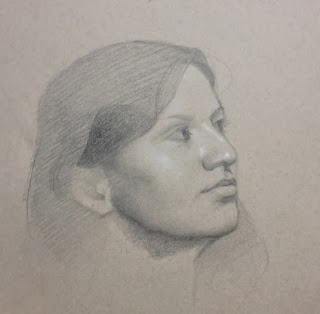 |
| Rebecca Gray |
 |
| Connor de Jong |
↧
Studio Visit
Recently a few students and I had the opportunity to visit the studio of Joshua LaRock, Michael Klein, and Brandon Beckstrom. We were in for a real treat. Rodrigo and I came over to see Michael's paintings before they were to be shipped out for a show to SR Brennen Galleries while Jessica and Charlie came to see some of Joshua's recent finished portrait commissions before they will be shipped out overseas. Being there felt a little like what the public must have experienced at one of those Salon de Paris exhibitions during the 19th century, just one gorgeous painting after the other, one on top of the next. What a group of talented and skilled artists. I have to admit, we all left feeling very inspired that day.
 |
| Rodrigo Mateo, Michael Klein, Brandon Beckstrom, Charlie Mostow, Jessica Artman, Leeanna Chipana, Joshua LaRock, and Tom LaRock |
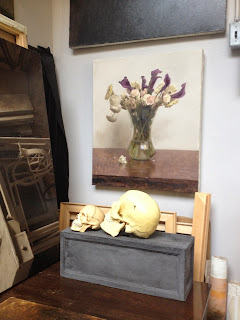 |
| Floral painting by Michael Klein |
 |
| "Beauty Veiled" by Michael Klein |
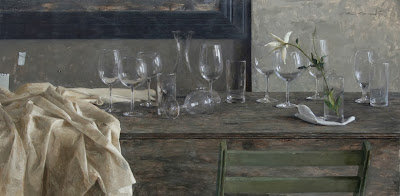.jpg) | |
| "Studio table with Flower and Glasses" by Michael Klein |
 |
| Always the consummate entertainer Brandon doesn't miss a chance to make the group laugh. Here he poses playfully with the studio skeleton. Talented and funny? Ladies watch out! |
↧
Ife - Yoruba Portrait Sculpture
Today, I decided to highlight some art I found particularly inspring. The Yoruba city of Ife in West Africa was the birthplace of a particularly incredible series of portrait sculptures in the 12th-14th century AD. I find it particularly interesting that a tradition of highly skilled naturalist sculpture developed independently from the Western Greco-Roman tradition. Evidently an interest in depicting people and things as they are is not necessarily unique to the West.
The Yoruba artistic tradition was centered around the concept of àṣẹ, the source of divine power that runs through all things on Earth. The head (orî) is considered to be the center of the àṣẹ in human beings. This philosophical understanding is the basis for the varied and exceptional sculpture of the Yoruba kingdom.
The concept of the inner and outer head is also a central feature of the Yoruba portrait. These images above are sculptures completed in the city of Ife, following the depiction of the outer head (its naturalistic physiognomy). The city of Ife was particularly proficient during the period of the 13th to 15th century in creating highly naturalistic sculpture work, possibly by a handful of artists working in a close-knit setting.
Yoruba portrait sculpture can also be highly symbolic to better depict the inner head in its metaphysical state - here I have only posted the naturalistic "outer head" sculptures due to their visual accessibility to us. In the sculpture of King Obalufon II, it is interesting to note that the purity of the copper (96.8-99.7%) surpasses the sculptures of Ancient Greece, Rome, the Italian Renaissance and Chinese bronze casters. (Blier)
Although we do not have a great understanding of who these artists were or their technical process, their work speaks for itself and crosses time and space to reach artists and art appreciators. I hope you can appreciate it.
 |
| Head, Possibly a King- terracotta |
 |
| Ife King - bronze |
 |
| Mask with Vertical Line Facial Markings - terracotta |
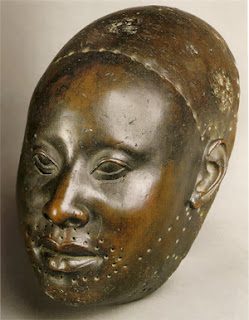 |
| King Obalufon II - copper |
The concept of the inner and outer head is also a central feature of the Yoruba portrait. These images above are sculptures completed in the city of Ife, following the depiction of the outer head (its naturalistic physiognomy). The city of Ife was particularly proficient during the period of the 13th to 15th century in creating highly naturalistic sculpture work, possibly by a handful of artists working in a close-knit setting.
Yoruba portrait sculpture can also be highly symbolic to better depict the inner head in its metaphysical state - here I have only posted the naturalistic "outer head" sculptures due to their visual accessibility to us. In the sculpture of King Obalufon II, it is interesting to note that the purity of the copper (96.8-99.7%) surpasses the sculptures of Ancient Greece, Rome, the Italian Renaissance and Chinese bronze casters. (Blier)
Although we do not have a great understanding of who these artists were or their technical process, their work speaks for itself and crosses time and space to reach artists and art appreciators. I hope you can appreciate it.
↧
↧
Hudson River Fellowship Applications Due Dec 2!
 |
| Travis Schlaht, Ted Minoff and Emilie Lee HRF 2011 |
Apply today to the 2014 Hudson River Fellowship!
Application Deadline: December 2, 2013
Fellowship Dates: July 13 - August 2 (July 13 & August 2 are travel days)
Location: Jackson, New Hampshire
Based out of Jackson Village nestled in New Hampshire's White Mountain National Forest, the Hudson River Fellowship will gather twenty landscape painters for a three-week collaborative fellowship to paint the landscapes that drew over 400 painters in the 19th century. Among these painters were Thomas Cole, Asher B. Durand, George Inness, Sanford Gifford, Jasper Cropsey, Albert Bierstadt and the New Hampshire native credited with founding the White Mountain School, Benjamin Champsey.
The dates of this summer's fellowship are July 13 - August 2. (July 13 and August 2 are travel days. ) The fellowship provides all accepted fellows with full tuition and free housing in one of two snug mountain chalets with gorgeous views. There is no application fee. There is a $100 non-refundable participation fee and a $100 housing deposit to be returned at the end of the fellowship. Fellows are responsible for their own transportation and food.
We are so lucky to have excellent local fellowship hosts! Painters Erik Koeppel and Lauren Sansaricq live and work in Jackson Village along with Warren and Leslie Schomaker of the Jackson Historical Society. Warren and Leslie help us book the lecture venues and gather the fellows for a Meet and Greet Sunset Party and organize an End of Fellowship Exhibition. Leslie also does a great job allaying concerns about black bears & ticks. Erik and Lauren help the fellows get oriented in the landscape, organize rainy day activities, invite Fellows to their studios for various art-related salons, demos and show and tell evenings.
Read More...
Apply Now!
SCROLL DOWN FOR IMAGES from the White Mountains
both historic & from the 2013 Fellowship...
 |
| Crawford Notch by Thomas Cole |
 |
| Echo Lake by Jasper Cropsey |
 |
| Mount Washington by George Inness |
.jpg) |
| Mount Chocorua by Sanford Gifford |
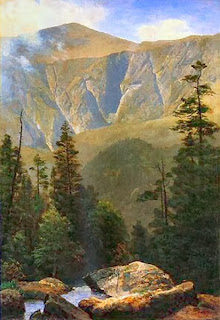 |
| Mount Washington by Albert Bierstadt |
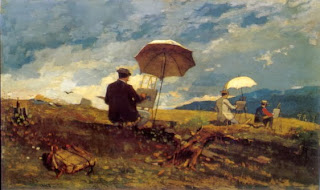 |
| Artists Sketching in the White Mountains 1868 by Winslow Homer |
 |
| 2013 Fellows at the Mountain View Road Chalet |
 |
| A Critique by Sr. Fellow Ted Minoff |
| A Demo by Sr. Fellow Erik Koeppel |
| Koeppel Demo for Fellows & Workshop Students |
 |
| Mount Chocorua by Erik Koeppel |
 |
| Steady-Hand Lauren Sansaricq!! |
 |
| Ted Minoff painting water...whhaaat?? |
 |
| Sr. Fellow Tom Kegler Demo |
| Tom Kegler Paints a Sunset |
Click here for MORE IMAGES of 2013 Fellowship work!
To Apply, click here!
↧
GCA Salon - "Imitation and Emulation in Art" Lecture and Discussion
The Grand Central Academy cordially invites the public to attend its second Salon event of the year, Imitation and Emulation in Art, an evening consisting of two short lectures and a moderated roundtable discussion. Caroline Ting, M.A. (Sorbonne) will be delivering the lectures, which will focus on the history of Western Art and methods of study employed from the Greeks to the 19th century academicians. The lecture will be split into two parts across the evening, interspersed with an ongoing moderated discussion of the topic.
The event will take place this Friday, November 8th, from 5:30 to 7:30 PM. It will be located on the GCA premises at 20 W 44th St, in Manhattan, New York.
 |
| Creation of Adam |
↧
Drawing the Skeleton
While drawing the figure, it's great to take a little time out of the day and draw the skeleton between sessions. Fortunately at GCA, we have access to a model skeleton, and we like to set him up near the model in both the sculpture and drawing/painting studios.
Last Wednesday we had a little extra time between poses and Rebecca took the time to set up the skeleton according to the model's position and lighting. It's a great exercise and very informative!
 |
| Rebecca Gray Drawing a Skeleton Alongside Her Figure Drawing |
↧
Zubin Mehta presents Mobilize Art
I think we can all agree the internet is an important marketing tool for artists. Even if you do not already have a website or a blog I am sure we can find you posting your latest works on Facebook or Pinterest. On Tuesday Zubin Mehta will introduce Mobilize Art, a new tool for artists to sell their work online. Please learn more by joining us Tuesday Nov. 12th from 5 p.m. - 6 p.m. in the cast room.
Contact Zubin Mehta to join his mailing list and learn more about Mobilize Art at ZubinM@mobilizeart.com
Contact Zubin Mehta to join his mailing list and learn more about Mobilize Art at ZubinM@mobilizeart.com
↧
↧
Love Letter to the Sculpture Studio
The sculpture studio in the GCA has been hopping lately! All core students are required to create several figure sculptures at some point in their scholastic career.
My experience with figure sculpture has been truly illuminating. Sculpting the forms of the figure is a chance to re-examine figure drawing in a manner where proportional, gestural and anatomical misunderstandings quickly become obvious. Weaknesses and strengths are more apparent, and gaps in knowledge that were previously waved away suddenly take center stage.
In my own humble opinion, after cast drawing, sculpture must be one of the best ways to sharpen the eye and the understanding of space. I look forward to continuing onwards with my classmates as we familiarize ourselves with the sculptural mindset.
 |
| Left to Right - Sam, Mark, Rebecca, Zoe, Connor, Abigail, Liz... and Cheh! Click for zoom |
In my own humble opinion, after cast drawing, sculpture must be one of the best ways to sharpen the eye and the understanding of space. I look forward to continuing onwards with my classmates as we familiarize ourselves with the sculptural mindset.
↧
Interview with Edward Minoff
Read up here on GCA teacher Edward Minoff's interview by Brad MacDonald - it provides some personal insight into Minoff's hijinks, as well as his approach to crafting paintings and what it takes to be an artist.
Here's a little excerpt:
Do you still practice? If so, what do your practice sessions look like?
Practice never ends. In my case, I feel like there is some linear trajectory to my artistic career, so in some way each painting is practice for the next painting. I think this is particularly true of my ocean paintings. I spend so much time studying wave forms and the nature of water and air and the interaction between the two. Each painting reflects an attempt to better understand some aspect or property of the ocean environment. They all start with an idea or an emotion, but once the painting is underway it becomes a puzzle to solve. I guess my solving that puzzle, or acceptance of a lack of resolution is practice for the next painting where I will try to overcome some new obstacle or carry on trying to resolve an ongoing challenge.
Click here to continue reading!
 |
| A-Frame Edward Minoff |
Do you still practice? If so, what do your practice sessions look like?
Practice never ends. In my case, I feel like there is some linear trajectory to my artistic career, so in some way each painting is practice for the next painting. I think this is particularly true of my ocean paintings. I spend so much time studying wave forms and the nature of water and air and the interaction between the two. Each painting reflects an attempt to better understand some aspect or property of the ocean environment. They all start with an idea or an emotion, but once the painting is underway it becomes a puzzle to solve. I guess my solving that puzzle, or acceptance of a lack of resolution is practice for the next painting where I will try to overcome some new obstacle or carry on trying to resolve an ongoing challenge.
Click here to continue reading!
↧
Andrew Bonneau - Moran Portrait Prize Finalist
Andrew Bonneau, GCA alum and Australian painter, was recently awarded the distinction of being a finalist in the Doug Moran National Portrait Prize, one of the most prestigious art prizes in Australia. Mr. Bonneau graduated from the GCA core program last year and returned to his native Cairns, Australia to further his career.
The above painting will be on display in Sydney for the next several months at Juniper Hall, located at 250 Oxford Street, Paddington in Sydney, Australia. Afterwards, it will continue to travel throughout regional galleries across the country. We're happy to see Andrew Bonneau keeping academic art alive in Oceania!
Check out his website to see more of his work.
.jpg) | |
| Self Portrait with Landscape |
Check out his website to see more of his work.
↧
Annual Thanksgiving Lunch Party
Our annual Thanksgiving lunch party at GCA was a great time with classmates, models, friends and family. We all enjoyed potluck dishes and deserts with some delicious Cuban food!
And of course, our atelier-wide famous limbo competition was the central event! We had a great turnout and fierce competition this year, with the bar set lower (or higher?) than ever before.
And of course, our atelier-wide famous limbo competition was the central event! We had a great turnout and fierce competition this year, with the bar set lower (or higher?) than ever before.
 |
| Connor limboing |
 |
| Onlookers abound |
 |
| Left to Right - Liz in 2nd, Peter in 1st*, Connor in 3rd |
↧
↧
HRF 2014 Application Deadline Extended
| Daniel G. daSilva and Savannah Tate Cuff painting at Jackson Falls, N.H. |
Good new artists! Due to the recent holiday and student requests we have extended this years Hudson River Fellowship deadline to December 13th.Fellowship dates are July 13 – August 2, 2014. Accepted artists will paint the landscapes surrounding Jackson, New Hampshire in the White Mountain National Forest among some of the finest artists in the country. Fellows will bunk together in cozy ski chalets with stunning mountain views and lectures will cover history, science and the methods and materials of 19th Century landscape painters who flocked to this region.
How to Apply:
1. Click here to fill out the online application.
2. Complete the following and email to gca.leeanna@gmail.com
- 5-7 digital images saved as jpgs at 72 dpi or pasted into a Word or PDF document. Do not include your name in your image titles. Please include images of work done from life. Subject matter is not limited to landscapes but can include figure, cast, and still life. Drawings are encouraged, particularly figure drawings. Please do not submit artwork made from photographs.
- A statement of intent of under 500 words.
- A resume (optional)
↧
Self-Representation in Paleolithic Art
I recently stumbled across an intriguing paper by Professor LeRoy McDermott of UCMO, where he presents a new take on the ancient "Venus" sculptures from the Paleolithic European continent and beyond. Their perplexing distortions of the body led me to consider them as only fertility symbols - however, McDermott posits that the sculptures are in fact representational depictions of the female sculptor, looking down upon her own figure.
The above sculpture is a restoration of the Lespugue Venus, a Venus figurine created in the Gravettian culture sometime between 24,000 to 26,000 years ago. It was discovered in a cave in the Pyrenees mountains of France in 1922.
Below, you can see the same sculpture, photographed from the top down, with the head as the viewpoint. This is then compared to a photograph of a 26 year old adult Caucasian female, whom is six months pregnant.
There are a few curious elements in the above images that make a lot of sense as a representational, rather than symbolic, work. Note the clear notch of the sacrum on the back view - its appearance is only so blunt from this sort of viewpoint. In the side view, the rectus femoris and vastus lateralis appear quite familiar, as does the rhythm of the gastrocnemius. McDermott also informs us that these figurines usually began with a rough shaping of the head, and then continued with refinement throughout the body. The stomach and reproductive organs were to be detailed last, at an advanced stage of pregnancy.
This form of self-representation explains the lack of detail or attention to the head, as well as the feet (hidden by the hips and legs). It also reveals the odd choice of proportion to be a preference for the viewer's perspective of the self.
I find this theory to be an attractive explanation, but it also begs the question of why? As representational artists, we are concerned with depicting things as faithfully as we see them, just as our ancient ancestors may have concerned themselves with depicting their bodies in a manner that made sense to them. Even in our attempts to describe what we visually see, we can often arrive at such different understandings of what that may mean.
Click here to read McDermott's paper in full
 |
| Photo Credit: M Burkitt 'The Old Stone Age' |
Below, you can see the same sculpture, photographed from the top down, with the head as the viewpoint. This is then compared to a photograph of a 26 year old adult Caucasian female, whom is six months pregnant.
 |
| Front View |
 |
| Side View |
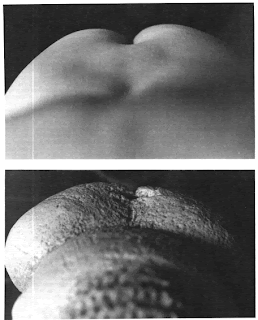 | ||
| Back View |
This form of self-representation explains the lack of detail or attention to the head, as well as the feet (hidden by the hips and legs). It also reveals the odd choice of proportion to be a preference for the viewer's perspective of the self.
I find this theory to be an attractive explanation, but it also begs the question of why? As representational artists, we are concerned with depicting things as faithfully as we see them, just as our ancient ancestors may have concerned themselves with depicting their bodies in a manner that made sense to them. Even in our attempts to describe what we visually see, we can often arrive at such different understandings of what that may mean.
Click here to read McDermott's paper in full
↧
Monday Portraits
↧























